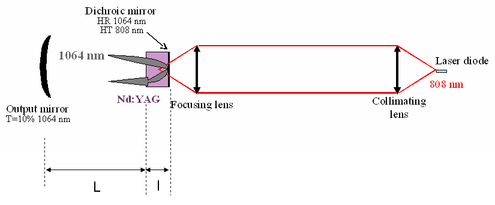
Introduction
The aim of this part is to study in practical terms a classical laser resonator such as the one described in the course “principle of laser”. This study is also useful to apply the notions of the present course to a “real” case.
Let us remind the geometry of the resonator and the different parameters we will use during the study :
-
a Nd:YAG crystal (length l=10 mm, refractive index n=1,8) is the amplifying medium in a two-mirrors linear cavity.
-
One mirror is directly coated on the crystal (this mirror is obviously a plane mirror) : the coating is HT (High Transmission) at the pump wavelength (808 nm), and HR (High Reflection) at the laser wavelength (1064 nm). Let A1 be the reflection coefficient around 1064 nm : A1 is close to unity. This mirror is made from a high number of very thin layers of low and high index materials: with this type of “dielectric coating”, almost every spectral shape could be given to the reflection coefficient.
-
The other mirror has a radius of curvature R and is used to close the cavity. Its coefficient of reflection at 1064 nm (A2) is below unity to let the laser beam escape from the resonator.
-
The distance between the uncoated end of the crystal and the output coupler is L. The total length of the resonator is consequently L+l (see figure).
